Synthetic sponges are toxic. Opt for a bio and effective alternative: The Loofah.
Did you know that your go-to sponge is stuffed with toxic and eco-toxic chemicals? Up to a few days ago, I didn’t know either. In this post, I will detail how this is. I even made a little experiment of my own... results are quite scary... Then I will present an amazing alternative: The Loofah.
Today, my kitchen sponge is a kind of large cucumber: Yes , you read well, a cucumber; a special type of cucumber called a loofah. And it does the job very effectively!
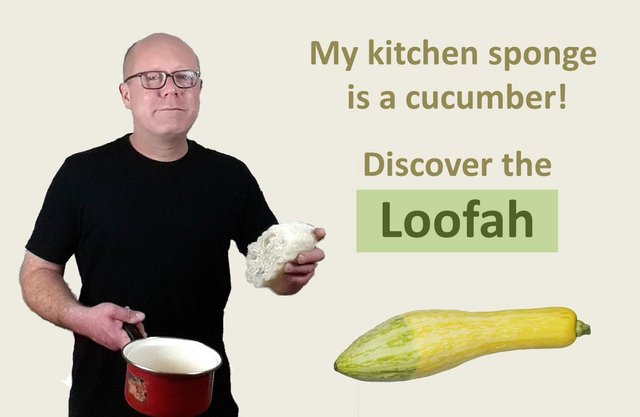
A few weeks ago, a friend (@delph-in-holland) gave me a piece of Loofah sponge for me to try. It didn’t look too appealing nor practical and I kind of forgot about it. Until, one day I ran out of sponges. Looking in my housecleaning closet, I found this thing and gave it a try.
I started cleaning the mountain of dishes that had been piling up in the kitchen. Well, I was just amazed. It works really well. Intrigued, I inquired about it, and at the same time investigated the toxicity of the sponges I used to buy in supermarkets.
Now, I am ready to replace all sponges in my house with Loofah, you will see, it's really a no-brainer!
Let's dive in...

1/ What are “supermarket” sponges made of ?
In essence, synthetic sponges are made from non-biodegradable polymers like polyurethane, synthesized from petroleum. Not really eco-friendly…
But wait it gets better…
Your supermarket sponges come in all ranges of colors, right? So there must be dyes that are added to give them their specific colors… Remember, when you do your dishes, the sponge you use is in close contact with your plates, glasses and cutlery…
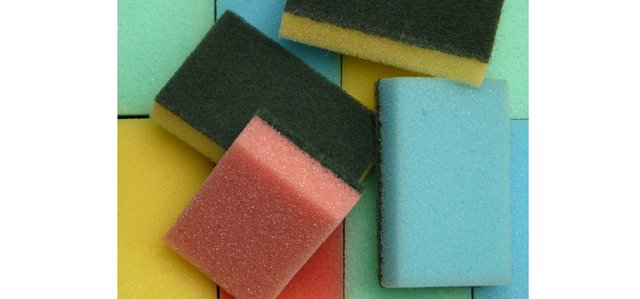
What are the compositions of the dyes used?
Well good luck finding out… For example I found a blog where the author found out that a ScotchBright sponge from 3M that he had purchased in a supermarket was leaking a blue dye.

3M responded. They wouldn’t inform the person of the composition of the die…”trust us, it is not toxic…”. Appalling… Check the avalanche of comments that followed: Many people using this product complained of the same thing, and some were even feeling sick after using the sponge…
I also made my little experiment. I plunged a brand new sponge in the mid price range (2 sponges for 1 Euro) in water. The water didn't turn blue, but was filled of particles of the abrasive side... beurk...
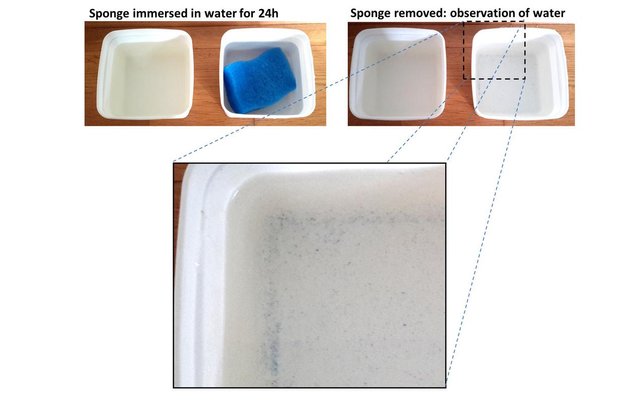
But this is not all…
A sponge can get quite unhealthy real soon: if just left soaking after use, sponges are great places for bacteria and fungi to develop. So industrials have found a solution - let’s stuff our sponges with chemicals like Triclosan -
Triclosan is an antibacterial and an antifungal agent that is known to be a suspected carcinogenic and an endocrine pertubator. It is also known to cause irritation and eczema in children and exhibit developmental and reproductive toxicity…. Additionally, it is also toxic to marine life… Your sponge, thrown away, leaks Triclosan which ends up in waterways.
People that market and push that shit should be in prison…

And guess what… we are not done yet with the list of the nice things synthetic sponges do to the environment…
You may have noticed that many sponges you find in supermarkets have an abrasive side… The abrasive side is made by blending nylon and polyester fibers, followed by a thermal process after dipping them into a mixture of chemicals that will act as a binder… Add to that an extra color dye… not too reassuring.
And what do you think keeps the two materials stuck together… Non-biodegradable glue, that ultimately leaks into the environment and that takes years before being fully degraded… That leads to reflecting on the biodegradability of the millions of synthetic sponges that are thrown away every day. Synthetic polymers used to make sponges do not degrade well and recycling them is a process that requires energy. So, usually the sponges you buy for cheap in a supermarket will not be recycled and are do not biodegrade readily…

2/ What is a Loofah?
That weird sponge is entirely composed of the fibers of a Cucurbitacea (cucumber family). The plant (official name L. aegyptiaca) is a tropical vine with its fruits being huge cucumber that hang in the air just like this:
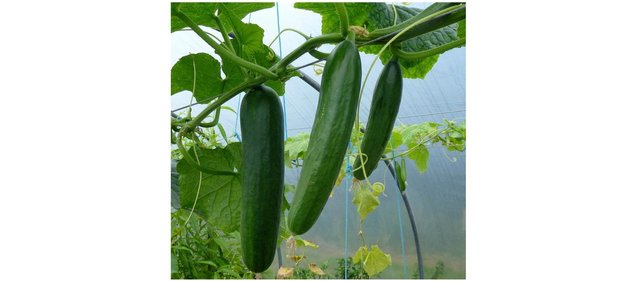
The development of the fruit starts with a large yellow flower… When the fruit is still small, it is edible, like a cucumber. If it is let to develop at maturity, the fruit develops quite an amazing property. The water within it progressively leaves, leaving only the cellulose fibers and the seeds.
When it feels kind of ‘spongy’ when pressing on it, it is ready for harvest. Remove the skin, and voila, you are now in possession of a 100% natural cellulose sponge of the highest quality, that you can cut and shape for the use you have in mind (house cleaning, dish washing, bathing, skin exfoliation etc…).
Yes, you can grow sponges...

The Loofah is actually the most ecological sponge that can be: it is made of the fibers of a fruit. That is all.

3/ The Loofah as an alternative to synthetic sponges.
First of all, always make sure when you buy a sponge that it is 100 % composed of vegetable fibers (for example, 100% cellulose)… In my humble opinion, within this scope, the ultimate best option is the Loofah.
It does require some care though, especially if you use it to scrub your body … but not more than any other sponge, synthetic or not. Allow your loofah sponge to dry by hanging it on a hook for example, and it can last you months. I noticed that just after use, the density of the fibers decrease significantly very fast, thus separating from each other. Consequently, the sponge becomes dry real quick, and it is well known that the best preservative is dryness.

Alternatively, you can bleach it (let it soak in diluted bleach for a few minutes), rinse well, and then hang it to dry. I know, this is not very ecological… yet, it is much better than throwing industrial sponges in the bin and buying new ones.
If you live in a country full of sun, an alternative to bleaching is to let the Loofah dry under sunlight immersing it with natural UV light that will make it more difficult for germs to develop. Another alternative is to heat your Loofah in boiling water for a few minutes in order to disinfect it. Note however, that all of these operations (bleaching, exposure to UV and immersing in boiling water) will damage the fibers on the long run, so be cautious not to overdo it. Loofah is degradable sponge after all!
As of the daily use, a Loofah is adapted for any task where a sponge is relevant. Just do not use the same Loofah for multiple purposes. For example, do not use the same Loofah for your skin and to scrub your pots and pans…

As soon as I discovered the Loofah, I inquired on how to grow some. I enjoy much gardening, so growing my own sponges, what a hoot! This plant loves humidity, but is really sensitive to cold… I live in The Netherlands: humidity, check; heat and sun, well…. Not really… So maybe one day in the future if I move to a hotter country …
If you wish to give a shot at growing some, seeds are available online, and once you get your first Loofah, each fruit will give you tens of seeds. If you do so, let me know how it goes!
Moreover, there are many ways to purchase Loofah sponges, and they can be quite cheap (A few dollars a sponge). Just investigate online. (note: Loofah is also commonly spelled Luffa).
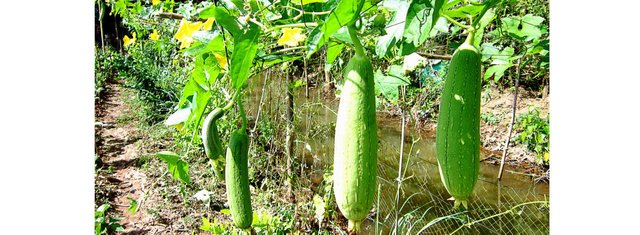
Of course, there are other alternatives than the Loofah. Some companies propose sponges that they claim are made entirely out of vegetable fibers and that are 100% recyclable… But I always had difficulties finding the truth out of what large corporations say… Their marketing and communication departments have lied so many times, that I cannot trust a single word of their communication...
To be complete, there is another category of sponges based on the skeleton of an animal that lives in the Mediterranean sea (See picture below). These are called natural sponges and were actually the first sponges used during the classical ages. However, these are animals living in a specific environment: considering this as an alternative for the world wide use of sponges would certainly bring them to the verge of extinction... Not a good idea...
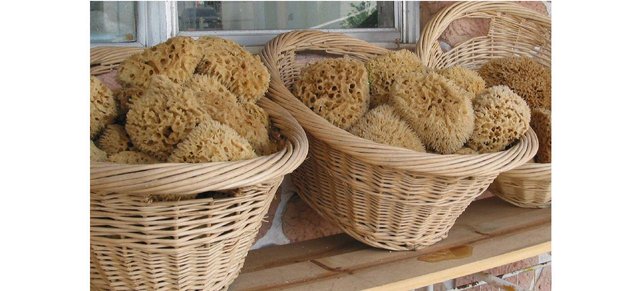
Conclusion
Every day, we use sponges, for cleaning our house, our bodies, our dishes. We use them without a second thought, and throw them in the bin when used…
This article reminds us of the consequences of this apparently insignificant action: industrial sponges we buy without a second thought in the supermarkets can be toxic, ecotoxic and non-recyclable. Yet affordable alternatives exists like the Loofah plant! For the luckiest of you that live in welcoming climates, you can even grow the sponges yourself (check http://luffa.info/ to get started)

References and to dig deeper
- https://lesbrindherbes.org/2014/02/01/les-substances-cachees-du-quotidien-leponge/
- http://www.organicauthority.com/sanctuary/whats-your-sponge-made-out-of-green-cleaning.html
- http://luffa.info/ https://en.wikipedia.org/wiki/Luffa
- https://en.wikipedia.org/wiki/Spongia_officinalis
- https://en.wikipedia.org/wiki/Sponge#By_humans
- https://happybabyusa.org/2013/03/19/scotch-brite-non-scratch-scrub-sponge-leaks-blue-dye/
- https://mightynest.com/learn/research-by-concern/dangers-of-triclosan
Image sources
The image of the 3 Loofah hanging is by Jonathan Billinger (link)
All pictures in this list were found on Wikimedia commons:
- Freeze was built from an image by Roger Culos (link)
- The Luffa sponge used to make the illustration with flower, luffa an sponge is by Sundar (link)
- The picture of the Loofah’s hanging to dry is By marinakvillatoro (Marina Kuperman Villatoro) (link)
- The picture of the Loofah growing under the strong sunlight is by Bùi Thụy Đào Nguyên (link)
- The picture of the natural sponges in baskets is by By Alcinoe (link)
The picture of the synthetic sponge leak was found on Joon's blog.

Hi,
I’m @muphy (see intro post),
My life revolves around music production, teaching sciences, and discovery through travel.
You enjoyed that post? Resteem and Upvote!
You are interested in these topics? Follow me!
Wonderful content sir and you had to back the claim with an experiment/study carried out to validate your point unlike a tons of content that just triggers fear in people without actual conviction with evidences. To even think I played with it as a kid growing up without knowing it's importance and use. Thank you for this post
Thank you for your comment.
Yes it is important for me to double check what I share on Steemit.
I always do some research before writing a post, and like to read various opinions and confront them, even when some views do not always fit with mine, i.e. I keep my eyes and mind open.
As I am putting forward strong accusations on a product in this post, I needed to check it for myself with this little test. You know, just to make sure I was not falling into sensationalism...
Mine too is a dried out cucumber, i farm cucumber at my backyard and i travelled over 2 weeks when i got home. It was dried. But turgid...and spongy...it just seemed so natural that i use it for my kitchen sponge which it did fantastically great job in cleaning...
Really? It works also with traditional cucumbers?
That, I can grow in The Netherlands... I already tried two years ago year, and it worked well, although they were too sour for my taste.
Maybe I can grow them again this year with a different objective :-), although I am not sure I can make them reach such maturity in the climate I live in.
Do you think it is possible to dry (mature) cucumber artificially so they can reach such a stage of spongyness?
That was a very interesting post :D I grow my own loofas every year and I actually throw them. I just place them for decoration and the fun of it. Now I have a use for them :D Thanks !
You are so lucky to be in a climate that allows you to do that!
And I am really glad that reading my words made you discover such a surprising use of your garden :-).
This year, when you grow them, why not take a picture every 3 weeks or so, up to maturity, and then write a post? I would love so much to be able to grow sponges in my garden.
I am too lazy to take pics... But I have a better counter offer. I will mail you some loofa-made sponges. How does that sound?
Wow! That does sound very sweet to my ears :-), thank you very much!
Maybe a few seeds too? I would send them to my mother: she is an amazing gardener, and as she lives in the South of France, she has a chance to succeed in growing Loofah sponges (Compared to me, in the Netherlands).
Where can I find you? on Discord?
oh, look! your name is there -> https://steemit.com/steemstem/@steemstem/steemstem-distilled-24 :P
Cool, thank you for letting me know!
Being more into Physics (i.e., botany is not my area of expertise), I am surprised to see my article on the Loofah part of that prestigious list.
This encourages me very much to dig outside of my comfort zone :-)
Ρε μα απ' αυτά φτιάχνονται τα σφουγγάρια για λούσιμο? Και το 'χα απορία από παιδί.
Solved.
Excellent way to help our health to stay fine, to nature and the planet in general. The advance of science in combination with conciena makes our lifestyles healthier. Personally, I have been using this type of natural sponge for about 2 years and the truth is that I have done very well, even better than the polyethylene-based contaminant! Thanks for your explanatory post that inspires you to have more conscience, greetings!
Thank you @efren.arnaude.
I just discovered the Loofah a week ago, so I am glad to see that my intuition for this plant is correct: you've been using it for 2 years, and you are happy with it - it is a very good sign! Thank you for sharing your experience with it.
Now we have to make people aware that they do not necessarily need to buy toxic sponges for their everyday use, and that the little effort to switch to the Loofah can also help the planet!
The fresh fruit itself is a good food source too, we used that in some dishes here in the Philippines. The dried(loofah) skeleton is a very natural bath scrub. I enjoyed your article @muphy. Thanks for all this wonderful info about this eco-friendly alternative. Upvoted an Resteemed. :)
When I discovered these, I immediately wanted to grow some, but the Dutch weather will not them do so!
I wonder how they taste like. Does Loofah taste like cucumber?
And thank you for your kind compliment on the post @lordkingpotato :-)
they grow easily in Africa
I definitely learned something today! These are common where I live (in Cyprus), we use them as bath sponges mostly, and I always wondered what they're made of.
Now I know!
I am glad to have lifted this mystery for you ;-)
When you say they are common, you mean they are also common to see growing around?
I should visit Cyprus one day, I never set foot there. Looks like a wonderful place, maybe a next holiday :-)
No I haven't seen them growing around. But I'm a city boy. Although cities here are nothing like elsewhere, but still. I meant common as finished products/sponges.
Don't know where else you've been, but if you love great weather and beaches and food, there's few places like Cyprus.
This is the best thing I have read today, @muphy! I have to try this at home. Thanks, sir! <3
Hey Angie! Long time no see my first Steemit friend <3!
Let me know if The Loofah works out with you when you try it out. You live in Qatar now right? Maybe a little dry to make them grow well. On the other hand, in The Philippines it should probably grow really well. When you come home, you should try :-)!
will take care of this and make it a habit of using it more thanks for sharing :)
Yes! give it a shot, and tell us how it goes!
Quite interesting
Thank you
This is a test comment, notify @kryzsec on discord if there are any errors please.
Being A SteemStem Member